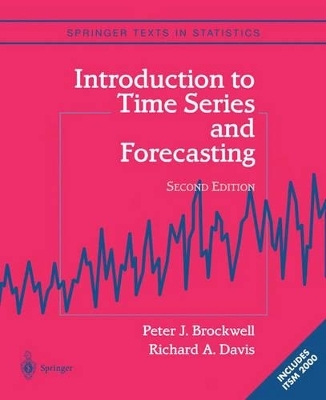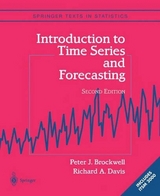Introduction to Time Series and Forecasting
Springer-Verlag New York Inc.
978-0-387-95351-9 (ISBN)
- Titel erscheint in neuer Auflage
- Artikel merken
Some of the key mathematical results are stated without proof in order to make the underlying theory accessible to a wider audience. The book assumes a knowledge only of basic calculus, matrix algebra, and elementary statistics. The emphasis is on methods and the analysis of data sets. The logic and tools of model-building for stationary and nonstationary time series are developed in detail and numerous exercises, many of which make use of the included computer package, provide the reader with ample opportunity to develop skills in this area. The core of the book covers stationary processes, ARMA and ARIMA processes, multivariate time series and state-space models, with an optional chapter on spectral analysis. Additional topics include harmonic regression, the Burg and Hannan-Rissanen algorithms, unit roots, regression with ARMA errors, structural models, the EM algorithm, generalized state-space models with applications to time series of count data, exponential smoothing, the Holt-Winters and ARAR forecasting algorithms, transfer function models and intervention analysis. Brief introductions are also given to cointegration and to nonlinear, continuous-time and long-memory models.
The time series package included in the back of the book is a slightly modified version of the package ITSM, published separately as ITSM for Windows, by Springer-Verlag, 1994. It does not handle such large data sets as ITSM for Windows, but like the latter, runs on IBM-PC compatible computers under either DOS or Windows (version 3.1 or later). The programs are all menu-driven so that the reader can immediately apply the techniques in the book to time series data, with a minimal investment of time in the computational and algorithmic aspects of the analysis.
Preface 1 INTRODUCTION 1.1 Examples of Time Series 1.2 Objectives of Time Series Analysis 1.3 Some Simple Time Series Models 1.3.3 A General Approach to Time Series Modelling 1.4 Stationary Models and the Autocorrelation Function 1.4.1 The Sample Autocorrelation Function 1.4.2 A Model for the Lake Huron Data 1.5 Estimation and Elimination of Trend and Seasonal Components 1.5.1 Estimation and Elimination of Trend in the Absence of Seasonality 1.5.2 Estimation and Elimination of Both Trend and Seasonality 1.6 Testing the Estimated Noise Sequence 1.7 Problems 2 STATIONARY PROCESSES 2.1 Basic Properties 2.2 Linear Processes 2.3 Introduction to ARMA Processes 2.4 Properties of the Sample Mean and Autocorrelation Function 2.4.2 Estimation of $/gamma(/cdot)$ and $/rho(/cdot)$ 2.5 Forecasting Stationary Time Series 2.5.3 Prediction of a Stationary Process in Terms of Infinitely Many Past Values 2.6 The Wold Decomposition 1.7 Problems 3 ARMA MODELS 3.1 ARMA($p,q$) Processes 3.2 The ACF and PACF of an ARMA$(p,q)$ Process 3.2.1 Calculation of the ACVF 3.2.2 The Autocorrelation Function 3.2.3 The Partial Autocorrelation Function 3.3 Forecasting ARMA Processes 1.7 Problems 4 SPECTRAL ANALYSIS 4.1 Spectral Densities 4.2 The Periodogram 4.3 Time-Invariant Linear Filters 4.4 The Spectral Density of an ARMA Process 1.7 Problems 5 MODELLING AND PREDICTION WITH ARMA PROCESSES 5.1 Preliminary Estimation 5.1.1 Yule-Walker Estimation 5.1.3 The Innovations Algorithm 5.1.4 The Hannan-Rissanen Algorithm 5.2 Maximum Likelihood Estimation 5.3 Diagnostic Checking 5.3.1 The Graph of $/t=1,/ldots,n/ 5.3.2 The Sample ACF of the Residuals
| Reihe/Serie | Springer Texts in Statistics |
|---|---|
| Zusatzinfo | biography |
| Verlagsort | New York, NY |
| Sprache | englisch |
| Maße | 195 x 260 mm |
| Gewicht | 1146 g |
| Themenwelt | Mathematik / Informatik ► Mathematik ► Computerprogramme / Computeralgebra |
| Mathematik / Informatik ► Mathematik ► Wahrscheinlichkeit / Kombinatorik | |
| ISBN-10 | 0-387-95351-5 / 0387953515 |
| ISBN-13 | 978-0-387-95351-9 / 9780387953519 |
| Zustand | Neuware |
| Haben Sie eine Frage zum Produkt? |

